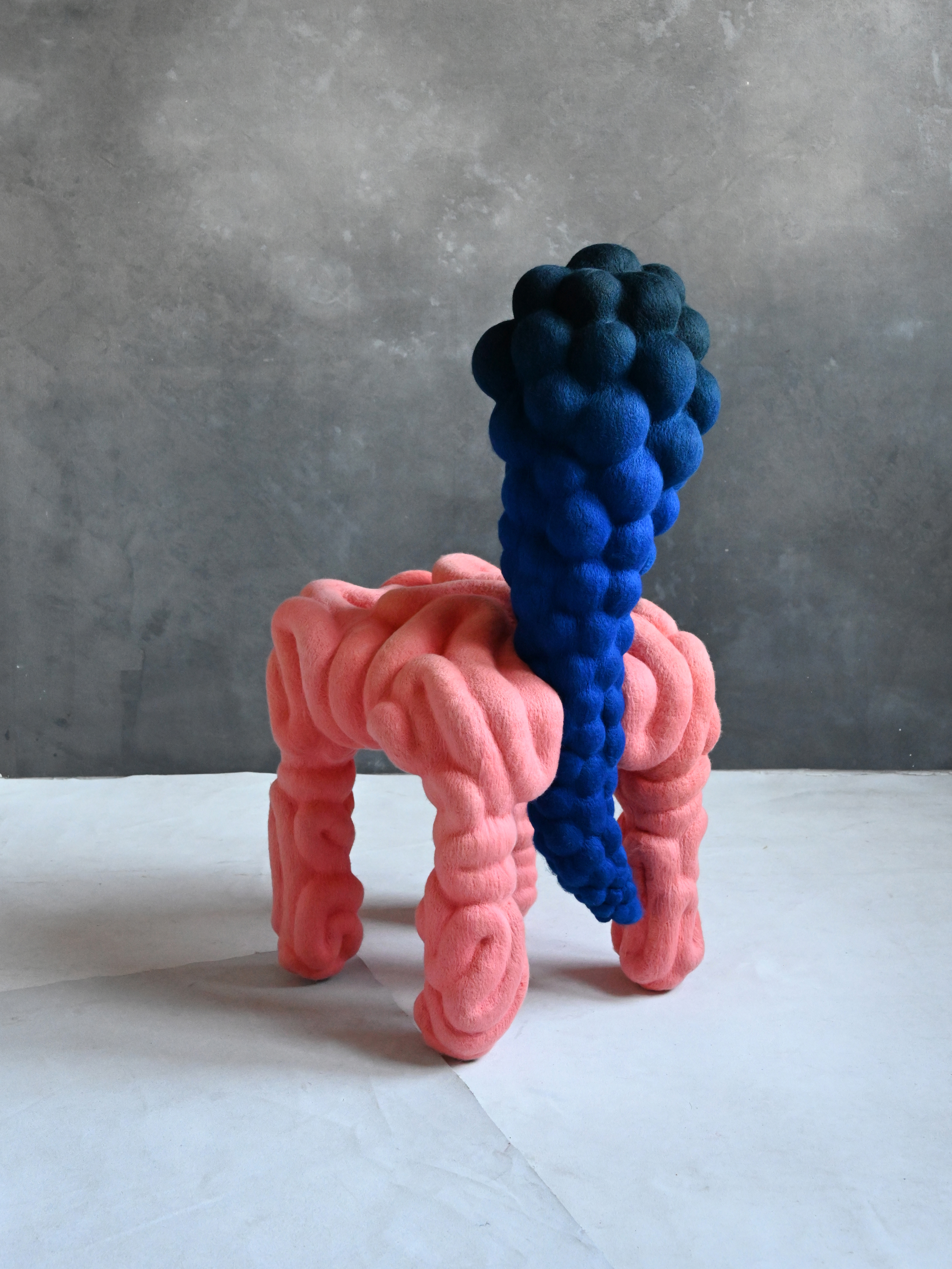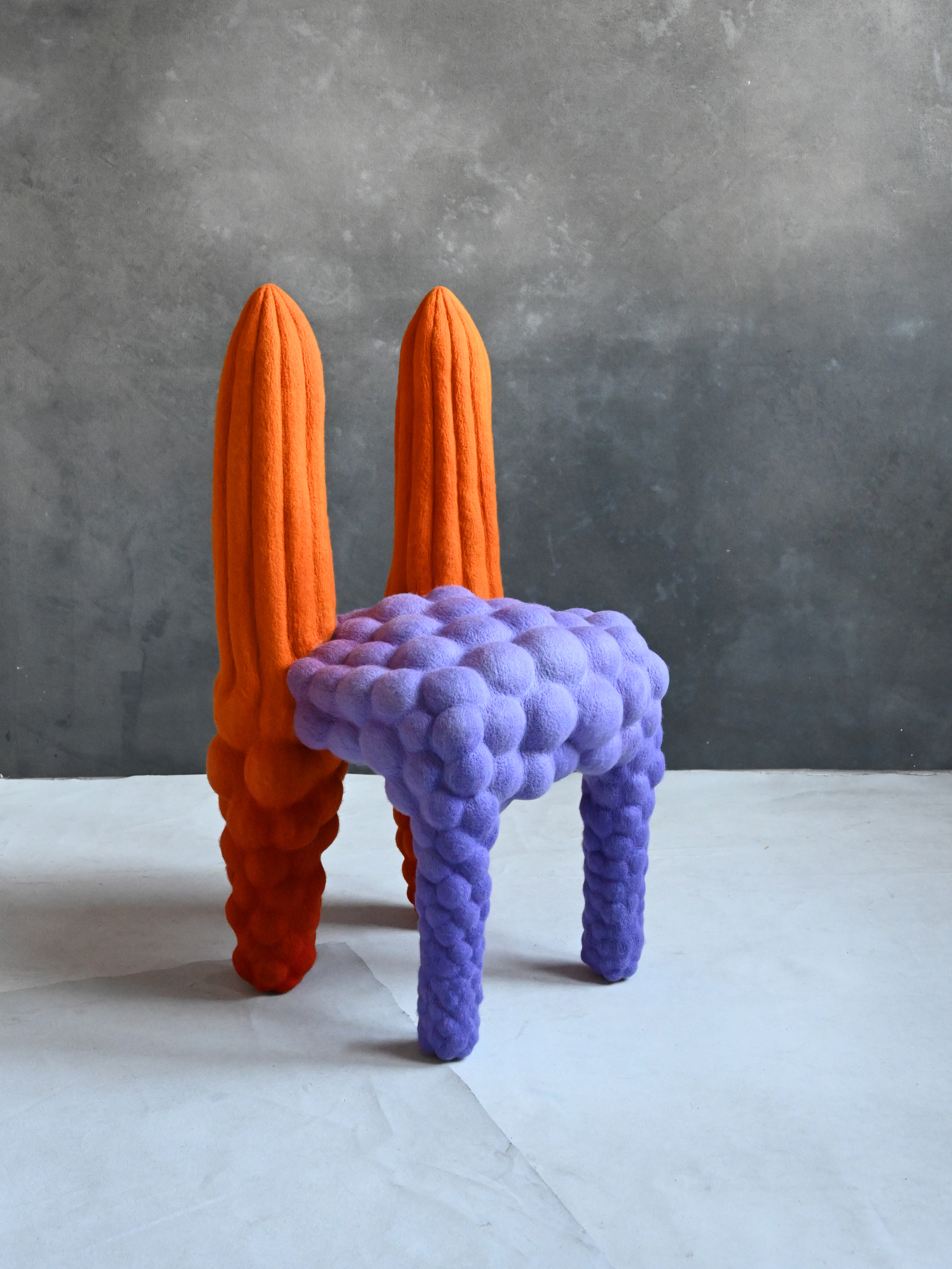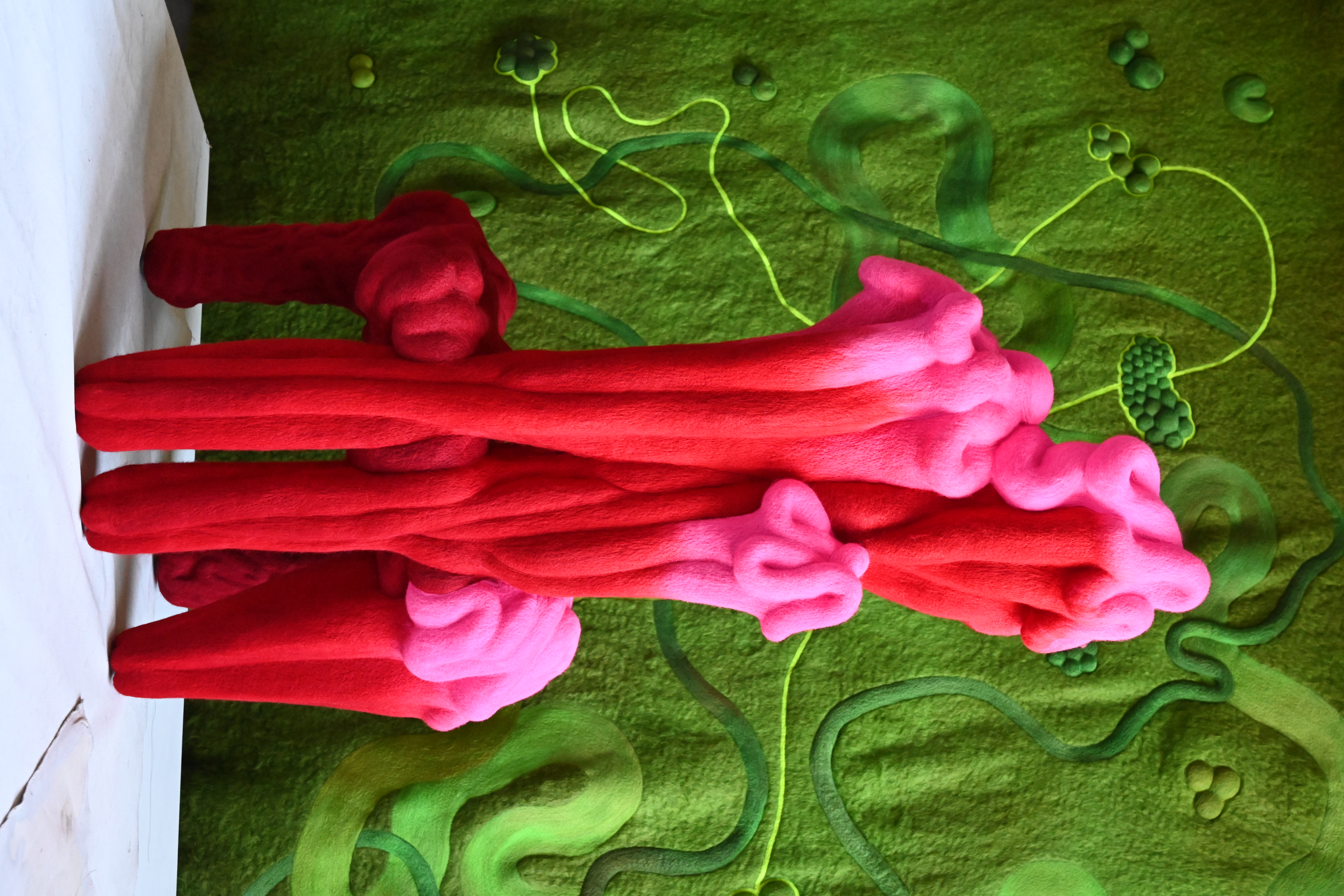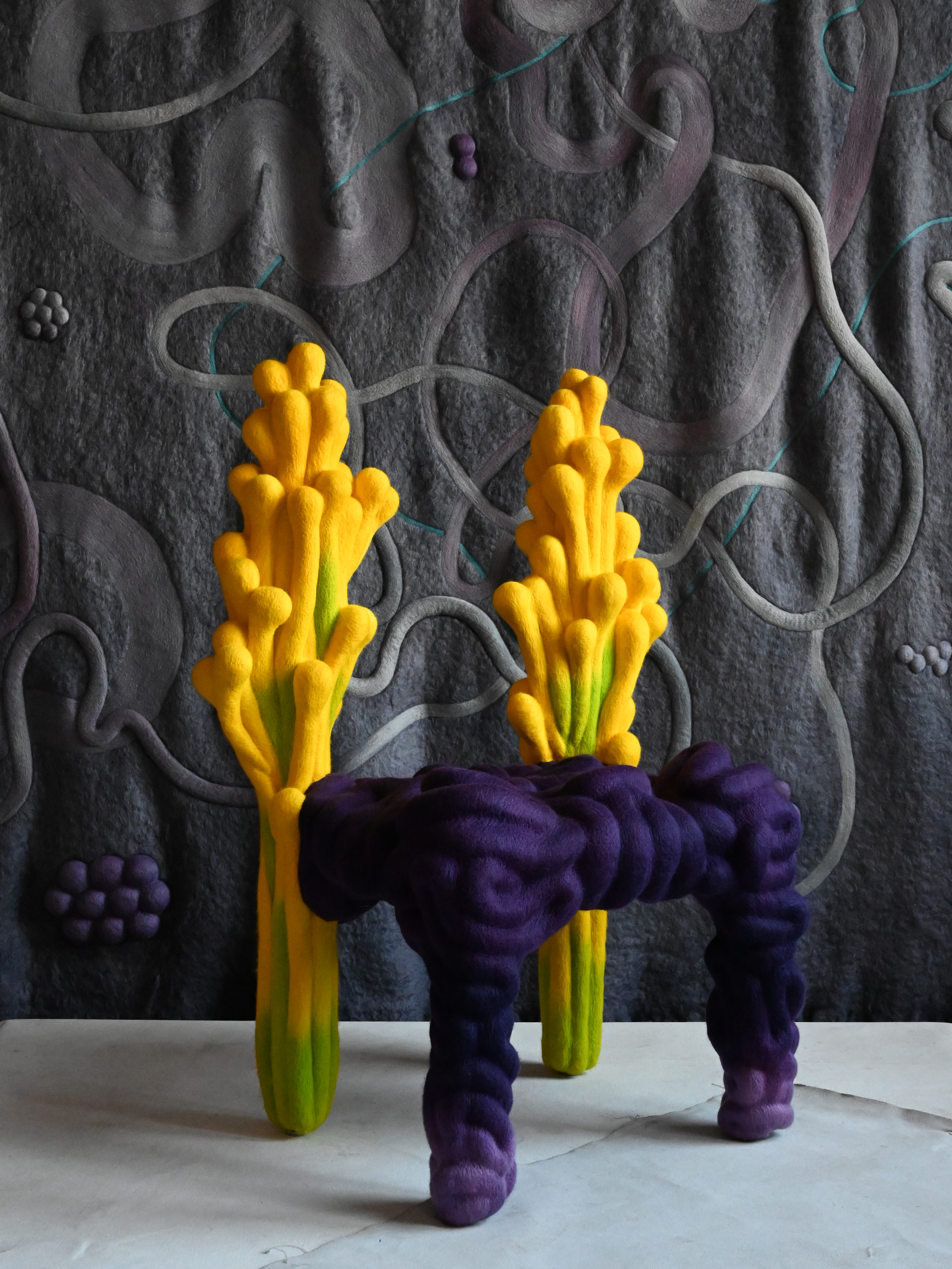
CONVERSATION
January 21st, 2022
By David Eardley
Header Photo by Chris Mottalini
︎One of my favorite things about running Pink Essay is getting to work with artists and designers with whom we’ve developed a professional friendship. With artist Liam Lee, I’ve been lucky enough to not only have an ongoing dialogue online, but to feature his work in my first solo curated show, Home Around You, which debuted last July.
I’m drawn to Liam’s work first and foremost by the color: the intensity of the dyed pieces is nearly supernatural, with deep tangerines and buzzing violets that suck you into another kind of universe. Liam launched his formal career as an artist with with his hand-felted textiles, crafting elaborate hanging pieces that emulated forms straight out of a petri dish, but has since taken the art and design community by storm with his sculptural furniture, which has been featured in Architectural Digest and Curbed. Liam and I met to speak about his new collection and to try to answer the big question: what is a designer?
Shapeshifting with Artist Liam Lee
January 21st, 2022
By David Eardley
Header Photo by Chris Mottalini
︎One of my favorite things about running Pink Essay is getting to work with artists and designers with whom we’ve developed a professional friendship. With artist Liam Lee, I’ve been lucky enough to not only have an ongoing dialogue online, but to feature his work in my first solo curated show, Home Around You, which debuted last July.
I’m drawn to Liam’s work first and foremost by the color: the intensity of the dyed pieces is nearly supernatural, with deep tangerines and buzzing violets that suck you into another kind of universe. Liam launched his formal career as an artist with with his hand-felted textiles, crafting elaborate hanging pieces that emulated forms straight out of a petri dish, but has since taken the art and design community by storm with his sculptural furniture, which has been featured in Architectural Digest and Curbed. Liam and I met to speak about his new collection and to try to answer the big question: what is a designer?
So the last time we spoke was around the time of our exhibition - it’s been more than half a year! So wild how quickly time passes. I don't remember if you had actually debuted any of your furniture pieces at that point…
I hadn’t yet - at that time I was being fairly secretive about the new work because they were very much experiments and weren’t yet ready to share. I started making the furniture because I suddenly had time to focus on my own work and really experiment after I was laid off from my day job due to the pandemic—I ended up making a little chartreuse stool as a prototype to see what I could accomplish with wool as a sculptural material.
Through my textile work, I realized that I could sculpt the wool into a very three dimensional, almost structural form. And I wanted to really try to push the material in that direction and see how sculptural it could become.

Over the past month I’ve been preparing another exhibition and thinking about this spectrum, from fine art all the way over to hyper–practical design. One thing that’s interesting about your process to me is that your work falls into different sections of this spectrum. For example, as an outside observer I’d consider your tapestries to be more along the lines of fine art, while your furniture is closer to design end of the spectrum. What has interacting with these labels been like for you as you’ve gotten into furniture?
I don't see either my textile work or the furniture as falling neatly within the realm of design because “design” as I have understood it, and maybe this is myopic, feels like it involves a relatively structured approach to the creation of objects, spaces, etc. My creative process doesn’t really involve the deliberate planning that I associate with design, like you might find in architecture for example, or more traditional product design, which both seem to require years of training in an institutional setting [laughs]. When I begin work on a piece, the form unfolds much more organically and I’m generally not aware of a precise outcome but am more so moving towards a vague direction that begins to solidify and take form as I work. In that sense, I feel much more comfortable thinking of my work as sculpture.
You bring up a good point that there's almost a need for different language, both a language around what design is and a language around for things that we feel don’t fit within our traditional notion of design. This is a fun thing to talk about in one of these interviews that we're using to relaunch the newsletter because I think this is one of these questions that's at the core of what Pink Essay is. What do we call the objects that fill our space and does that nomenclature need to come from like the person who built them or an outside observer?
I would also push you - that is, I wonder if your own perception of yourself is coming from a response to gatekeeping - this idea that only people who have studied design in a traditional school setting have the right to label their work that way. A famous person named RuPaul once said, our inner saboteur is always telling us we’re not enough - that my work isn't design because I didn't go to school for it.

So, like, from my perspective, I feel like your work is both sculpture and fine art and design at the same time. Even if you don't feel like you use “the design process,” I think it’s your right as the creator to decide what you want your work to be perceived as. It's interesting. It's a big, big question.
Definitely a big question. I think my hesitance to call what I do design work stems from imposter syndrome to some extent—I studied English as an undergrad and my path towards what I’m doing now has felt circuitous. My design education has come primarily from working in design-adjacent jobs, but I’ve also worked plenty of less related jobs, like at a PR agency for biotech companies and at a small arts foundation.
Before the pandemic, I worked for a set designer which, while very creative, felt to me to be much more of a production role, helping to facilitate the realization of a client or art director’s vision rather than my own (but I suppose that’s what a large portion of design work is!). I’ve also worked in an editorial capacity, compiling an architecture monograph for Reiser + Umemoto, which was an incredibly eyeopening and inspiring experience, both in terms of seeing how their firm operated on a daily basis and learning more about how their practice has evolved over time while retaining a very palpable unifying thread.

Do you feel like your interaction with social media and marketing your work has changed since you delved more into the sculptural furniture pieces?
In terms of social media, the major thing that has changed in how I present my work is that I'm trying to show how it exists in a physical space. Before, the work was presented in a very two dimensional way. I would crop the edges of the textile pieces and it felt much more 2D. I’ve been more inclined to show how my work inhabits space—and this I think is due to creating more three-dimensional sculptural pieces, but it has also changed in how I want to present my textile work.
There’s something extremely physical about the new pieces you’ve been making - sort of probiotic, in a way.
Yeah—they can be very visceral. I look at various plants, mushrooms, seed pods, bacteria, and the human body—some of the forms are definitely phallic. The hope is to trigger a visceral response in the viewer or user … a moment of ambiguous recognition of a form that is at once familiar and alien. Playing with scale can help create this confusion.


I LOVE that you’re thinking that way, Because I think that design has become so innocuous the past couple of years - not necessarily in the content of it, but in just insisting on being really inoffensive aesthetically. Everything is so pastel and squiggly and cutesy and it gets kind of annoying at some point. Your work is definitely post-cutesy [laughs].
[Laughs] I’m glad that you think my work is post-cutesy! Of course, I’m aiming to make things that people will find aesthetically pleasing, but I also hope that my work can be challenging in some way, whether it’s through the materials or processes used in its creation, or through the form and color of the work itself. There’s a lot of room for beauty without sterility. Aside from hoping to avoid an aesthetic flattening into millennial repetition, I don’t really know what I’m doing other than trying to create work that I find interesting to make and to think about.
But that's honestly how the best stuff happens. I think we all have no idea what we're doing - some of us are better at pretending we do. I literally have no idea what I'm doing any moment of the day.
Do you have any big dreams of where you’d like to see your work?
I’m really excited that Patrick Parrish Gallery has opened up my work to a new audience, and it’s been exhilarating to see how people interact with it in a public setting. This year, I'd also love to develop work that is accessible to a broader range of people, whether it’s through functional ceramics or some other medium.︎
Explore more of Liam Lee at @studio_liamlee and studioliamlee.com.

